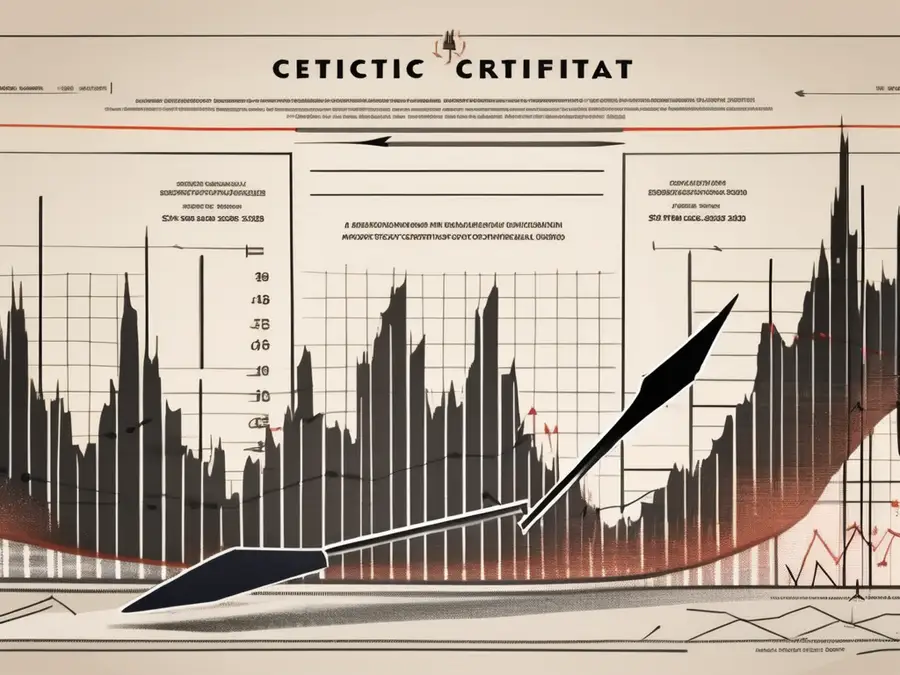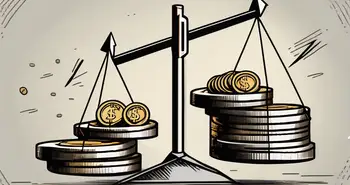Understanding the Impact of a Stock Split on Shareholders

In the world of stock markets, one term that often comes up is “stock split.” As an expert in the field, I am here to help you understand the impact of a stock split on shareholders. Let's dive into the details and explore the various aspects of this phenomenon.
Defining a Stock Split
A stock split is a corporate action that involves dividing the existing shares of a company into multiple new shares. The overall value of the company remains the same, but the number of shares increases. This division is typically done in a specific ratio, such as 2-for-1 or 3-for-1, meaning that for every share held, shareholders receive two or three additional shares, respectively.
The Basics of Stock Splits
Stock splits are essentially a cosmetic change in the structure of shares. The total value of the company and the ownership stake of shareholders do not change. The split merely adjusts the price and quantity of shares, making them more accessible and affordable for small investors.
When a stock split occurs, the company's share price decreases proportionally to the split ratio. For example, in a 2-for-1 stock split, if the original share price was $100, it would be halved to $50 after the split. At the same time, the number of shares held by each shareholder doubles. So, if an investor originally held 100 shares, they would now have 200 shares.
Stock splits are typically implemented by companies that have seen a significant increase in their share price. By reducing the price per share, the company aims to make its stock more attractive to a wider range of investors, including those with limited funds. This increased accessibility can lead to a larger investor base and potentially more trading activity.
Why Companies Choose to Split Stocks
Companies often decide to split their stocks for various reasons. One primary motivation is to increase liquidity in their shares. Lowering the price can attract more individual investors who might have been deterred by a higher share price.
Another factor behind stock splits is market psychology. By reducing the price per share, companies can create a perception of affordability and boost interest in their stock, potentially leading to increased trading activity.
Stock splits can also be seen as a positive signal to the market. When a company announces a stock split, it is often interpreted as a sign of confidence in the future performance of the company. This can generate positive sentiment among investors and potentially drive up the stock price.
Furthermore, stock splits can help to improve the liquidity of a company's shares. With more shares available in the market, it becomes easier for investors to buy and sell the stock, which can lead to increased trading volume and a more efficient market.
It is important to note that stock splits do not change the fundamental value of a company. The underlying financials and business prospects remain the same. The split is purely a technical adjustment that aims to make the stock more accessible and attractive to investors.
In conclusion, stock splits are a corporate action that involves dividing the existing shares of a company into multiple new shares. They are primarily done to increase liquidity, attract more investors, and create a perception of affordability. While stock splits can have positive effects on trading activity and market sentiment, they do not alter the fundamental value of a company.
The Immediate Effects of a Stock Split
When a stock split occurs, it has several immediate effects on shareholders. Let's take a closer look at these effects:
Changes in Share Price
The most apparent impact of a stock split is a decrease in the share price. For example, if a stock was trading at $100 per share before a 2-for-1 split, the post-split price would be $50. The reduced price makes the shares more attractive and accessible to a wider range of investors.
Lowering the share price through a stock split can have various implications for the market. Firstly, it can create a perception of affordability, attracting new investors who may have previously considered the stock too expensive. This influx of new investors can lead to increased liquidity in the stock, as more shares are being traded. Additionally, a lower share price can also make the stock more appealing to retail investors who may have limited funds to invest. This increased demand from retail investors can potentially drive up the stock price in the long run.
Furthermore, a decrease in share price due to a stock split can also have psychological effects on existing shareholders. Seeing the price of their shares drop may cause some shareholders to panic or question the value of their investment. However, it's important to note that the overall value of their investment remains the same, as they now hold a larger number of shares at a lower price.
Increase in Number of Shares
With a stock split, shareholders receive additional shares in proportion to their existing holdings. For each share owned before the split, shareholders now own multiple shares post-split. This increase in the number of shares doesn't change the proportional ownership or the overall value of the investment.
From a shareholder's perspective, the increase in the number of shares can have both positive and negative implications. On the positive side, having more shares can potentially increase the dividend income received by shareholders. If the company continues to pay out the same amount in dividends, shareholders will now receive more dividend payments due to the increased number of shares they hold.
On the negative side, the increase in the number of shares can dilute the ownership stake of existing shareholders. While the proportional ownership remains the same, the increase in the total number of shares outstanding can reduce the percentage ownership held by individual shareholders. This dilution can be a concern for some investors, especially if they were holding a significant stake in the company prior to the stock split.
Additionally, the increase in the number of shares can also impact the voting rights of shareholders. In some cases, the increase in shares may result in a decrease in the voting power of individual shareholders, as their percentage of total shares outstanding decreases. This can potentially affect the ability of shareholders to influence corporate decisions through voting.
Overall, a stock split can have various immediate effects on shareholders, including changes in share price and an increase in the number of shares. While the immediate impact may be apparent, it's important for investors to consider the broader implications and potential long-term effects of a stock split on their investment.
Long-Term Impact of Stock Splits
While the immediate effects of a stock split are tangible, it's essential to consider the long-term impact as well. Let's discuss two significant aspects:
Potential for Increased Liquidity
Stock splits can enhance liquidity by attracting more buyers and sellers. With a lower share price, the trading volume tends to increase, potentially making it easier for shareholders to buy or sell their shares when desired.
Increased liquidity can have several benefits for investors. Firstly, it reduces the bid-ask spread, which is the difference between the highest price a buyer is willing to pay and the lowest price a seller is willing to accept. A narrower bid-ask spread means that investors can execute trades more efficiently and at a lower cost.
Furthermore, higher liquidity can also lead to improved price discovery. When there are more buyers and sellers in the market, the stock price is more likely to reflect the true value of the company. This can provide investors with more accurate information when making investment decisions.
Perception and Market Psychology
Stock splits can influence market psychology. Many investors perceive stock splits as a positive sign, signaling that a company is performing well and has confidence in its future prospects. This positive perception can generate increased demand for the company's shares and drive up the stock price over the long term.
One reason for this perception is the belief that a stock split makes shares more affordable and accessible to a wider range of investors. When a company's stock price increases significantly, it may become too expensive for some investors to purchase even a single share. However, after a stock split, the lower share price may attract new investors who were previously unable to participate in the market.
Moreover, stock splits can create a sense of momentum and excitement among investors. When a company announces a stock split, it often generates media attention and investor interest. This increased attention can lead to a positive feedback loop, with more investors buying the stock, driving up the price, and attracting even more investors.
It's important to note that while stock splits can have positive effects on market psychology, they do not guarantee long-term price appreciation. The underlying fundamentals of the company, such as its financial performance and competitive position, ultimately determine its stock's value.
The Role of Dividends in Stock Splits
In addition to the effects on share price and quantity, stock splits also impact dividends. Let's examine two important aspects related to dividends:
Dividend Adjustments Post-Split
After a stock split, companies typically adjust their dividends to reflect the increased number of shares. This adjustment ensures that shareholders continue to receive a proportional dividend based on their increased shareholdings. For example, if a company had a stock split of 2-for-1 and previously paid a dividend of $0.50 per share, after the split, the dividend per share would be adjusted to $0.25. However, since the number of shares has doubled, the overall dividend payout to shareholders remains the same. This adjustment is important to maintain fairness and consistency in dividend distributions.
Dividend adjustments post-split can have different implications for investors. On one hand, the decrease in the per-share dividend amount may be seen as a negative for some investors who rely on dividend income. However, from a broader perspective, the adjustment ensures that shareholders still receive a proportional dividend based on their increased shareholdings. This can be viewed as a positive aspect, as it maintains the relative value of the dividend income for shareholders.
Dividend Yield Considerations
Dividend yield is a popular metric used by investors to assess the income potential of a stock. It is calculated by dividing the annual dividend per share by the stock's current market price. In the context of stock splits, the dividend yield decreases post-split because the share price is lower, while the dividend payout remains the same.
For example, let's say a company had a stock split of 2-for-1 and previously paid an annual dividend of $2 per share. Before the split, the stock was trading at $100 per share, resulting in a dividend yield of 2%. After the split, the share price would be halved to $50, while the dividend payout remains at $2 per share. As a result, the dividend yield post-split would be 4%, reflecting the decrease in share price.
It's important for investors to consider this adjustment when evaluating the attractiveness of a dividend-paying stock. A lower dividend yield post-split may indicate a decrease in the income potential of the stock. However, it's crucial to analyze the overall financial health and growth prospects of the company in conjunction with the dividend yield to make informed investment decisions.
In conclusion, stock splits impact dividends in terms of dividend adjustments post-split and dividend yield considerations. While the per-share dividend amount decreases after a split, the overall dividend payout to shareholders remains the same, ensuring fairness. Additionally, the dividend yield decreases post-split due to the lower share price, which investors should consider when assessing the income potential of a stock. Understanding these aspects can help investors make informed decisions regarding dividend-paying stocks.
Stock Splits and Shareholder Value
When considering stock splits, it's crucial to assess the impact on shareholder value. Let's delve into two key aspects:
Evaluating Company Performance Post-Split
While stock splits can create temporary excitement in the market, it's crucial for shareholders to evaluate the underlying fundamentals of the company. A stock split alone may not necessarily indicate improved performance or value. It's important to conduct thorough research and assess the company's financials to make informed investment decisions.
One important factor to consider when evaluating company performance post-split is the potential impact on earnings per share (EPS). A stock split does not directly affect a company's earnings, but it can have an indirect impact on EPS. If the company's earnings remain the same or increase after the split, the EPS will likely decrease due to the increase in the number of shares. However, a decrease in EPS does not necessarily indicate a decline in shareholder value. It's essential to analyze other financial metrics, such as revenue growth, profit margins, and return on equity, to get a comprehensive understanding of the company's performance.
Additionally, investors should examine the company's competitive position within its industry. A stock split may attract more investors and increase liquidity, but if the company faces intense competition or struggles to differentiate itself, the long-term impact on shareholder value may be limited. Understanding the company's market share, customer base, and product portfolio can provide valuable insights into its ability to generate sustainable growth and create value for shareholders.
Understanding Dilution and Consolidation
Dilution and consolidation are concepts often associated with stock splits. Dilution refers to the potential decrease in the ownership stake of existing shareholders due to the increase in the number of shares. When a company announces a stock split, it typically increases the number of outstanding shares, which can dilute the ownership percentage of existing shareholders. However, this dilution does not necessarily result in a decrease in shareholder value.
On the other hand, consolidation involves reducing the number of shares through a reverse stock split. This process aims to increase the share price by reducing the supply of shares in the market. While consolidation can give the illusion of increased shareholder value due to a higher stock price, it does not guarantee improved company performance or financial health.
Investors should carefully consider the potential dilution or consolidation effects of a stock split and evaluate the company's overall strategy. It's important to assess whether the stock split aligns with the company's growth plans and if it is a strategic move to attract new investors or enhance market liquidity.
Furthermore, it's essential to analyze the company's capital structure and debt levels. A stock split may have implications for the company's ability to raise capital in the future. If the company has a high debt burden or limited access to financing, a stock split may not be the most effective way to enhance shareholder value.
In conclusion, while stock splits can generate excitement and attract investor attention, shareholders must dig deeper to evaluate the impact on shareholder value. Conducting thorough research, analyzing company performance, understanding dilution and consolidation effects, and assessing the company's overall strategy are crucial steps in making informed investment decisions.
Navigating Stock Splits as an Investor
As an investor, it's essential to understand how to navigate stock splits effectively. Here are some strategies and considerations:
Strategies for Investing in Split Stocks
One strategy is to take advantage of the increased liquidity and potential market psychology associated with stock splits. By carefully researching and selecting fundamentally sound companies that have recently split their stocks, investors can position themselves to potentially benefit from any long-term price appreciation.
Risks and Opportunities in Stock Splits
While stock splits can offer opportunities, it's important to be aware of the risks as well. Stock prices can be influenced by many factors, and a split alone does not guarantee positive returns. Investors should consider the company's financial health, industry dynamics, and market conditions before making any investment decisions.
FAQ
What is a stock split?
A stock split is a corporate action where a company divides its existing shares into multiple new shares. The purpose is to adjust the price and quantity of shares, making them more accessible to a broader range of investors while maintaining the overall value of the company.
How does a stock split affect shareholders?
A stock split primarily impacts shareholders by decreasing the share price and increasing the number of shares they hold. The proportional ownership and overall value of the investment remain the same. Additionally, stock splits can enhance liquidity and potentially influence market psychology.
What happens to dividends after a stock split?
After a stock split, companies typically adjust their dividends to reflect the increased number of shares. While the per-share dividend amount decreases, the overall dividend payout to shareholders remains the same. Investors should consider the impact of dividend adjustments on dividend yields.
Should I invest in companies that have recently split their stocks?
Investing in companies that have recently split their stocks can offer potential opportunities. However, it's crucial to conduct thorough research and evaluate the company's financials, industry dynamics, and market conditions. A stock split alone does not guarantee positive returns, so prudent analysis is essential.
As an expert in the field, I advise shareholders to stay informed, conduct appropriate research, and seek advice from financial professionals before making any investment decisions related to stock splits. Understanding the impact of stock splits is crucial in navigating the dynamic world of the stock market. Remember, it's always important to assess the underlying fundamentals of a company and consider the broader market conditions to make informed investment choices.
As you consider the implications of stock splits on your investment strategy, explore the innovative world of trading with Morpher. Embrace the future of investing on a platform that offers zero fees, infinite liquidity, and the ability to trade a wide array of assets with fractional shares. Whether you're looking to capitalize on market movements through short selling or amplify your trades with up to 10x leverage, Morpher provides a unique, blockchain-based trading experience that's tailored to the modern investor. Sign Up and Get Your Free Sign Up Bonus today to transform the way you trade and take control of your financial future.

Disclaimer: All investments involve risk, and the past performance of a security, industry, sector, market, financial product, trading strategy, or individual’s trading does not guarantee future results or returns. Investors are fully responsible for any investment decisions they make. Such decisions should be based solely on an evaluation of their financial circumstances, investment objectives, risk tolerance, and liquidity needs. This post does not constitute investment advice.

Painless trading for everyone
Hundreds of markets all in one place - Apple, Bitcoin, Gold, Watches, NFTs, Sneakers and so much more.

Painless trading for everyone
Hundreds of markets all in one place - Apple, Bitcoin, Gold, Watches, NFTs, Sneakers and so much more.









